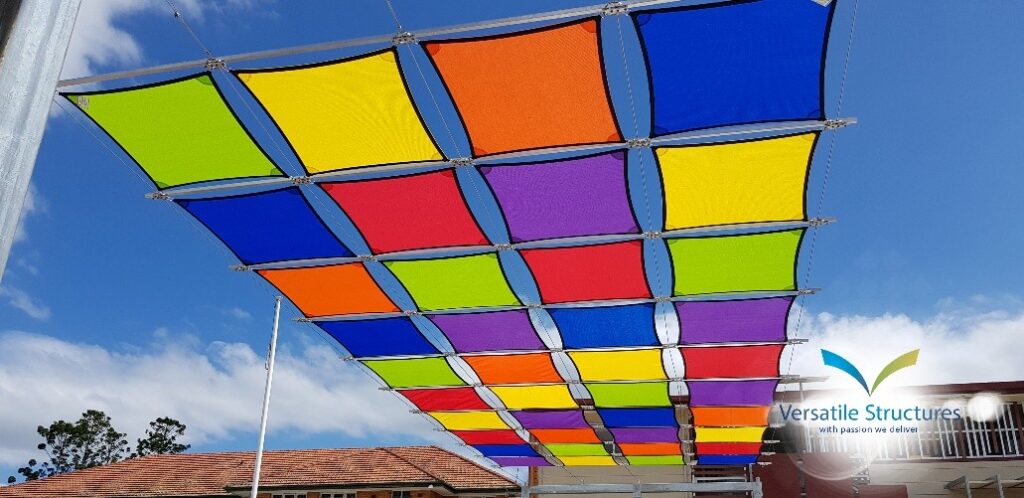Shade structures are essential in designing modern urban and public spaces. They are far more than just practical installations; they actively balance functionality, aesthetics, and sustainability. Whether installed in parks, schools, commercial districts, or cultural sites, well-designed commercial shade structures contribute significantly to public comfort, energy efficiency, and the artistic identity of a location.
As cities grow and urban planning evolves, the role of premium shade solutions in enhancing liveability and sustainability has become critically important.
The Functional Benefits of Shade Structures
The primary purpose of a shade structure is protection from the sun, but its benefits are extensive. Modern shade structures are engineered to reduce heat exposure, enhance outdoor usability, and contribute to energy savings across urban environments.
Reducing Heat and Sun Exposure
Excessive sun exposure can cause discomfort and serious health risks. Commercial shade structures in parks, playgrounds, and pedestrian zones offer a much-needed respite. They allow people to enjoy outdoor spaces without the threat of overheating or severe sunburn. Sunshades for parks and schools are especially beneficial for creating safe, UV-protected play areas for children.
Enhancing Outdoor Usability
Shaded areas make urban environments more versatile and accessible throughout the year. Outdoor restaurants, shopping precincts, and recreational zones benefit from strategically designed shade structures, allowing customers and visitors to comfortably enjoy activities regardless of heat or sun exposure. By incorporating urban shade solutions, cities can improve public comfort, encourage foot traffic, and create more vibrant, functional outdoor spaces.
Improving Energy Efficiency
Well-designed and strategically placed shade structures can significantly reduce heat accumulation in surrounding areas. When positioned near buildings, they block direct sunlight, lowering indoor temperatures and reducing the reliance on air conditioning. This not only enhances comfort but also contributes to energy efficiency and lower cooling costs in both commercial and public facilities.
The Aesthetic Impact of Shade Structures
Beyond their practical benefits, shade structures significantly influence the visual and architectural appeal of modern urban environments. Contemporary architectural shade designs are created not only to provide comfort and protection but also to complement existing buildings, introduce creativity, and even stand as visual landmarks within a cityscape.
Blending Functionality with Artistic Expression
Modern shade structures are no longer just functional canopies—they’re architectural statements. Many urban planners and landscape designers now use sculptural shade solutions that serve both practical and artistic purposes. These shade structures for art installations often feature bold forms, vibrant colours, and textured finishes, transforming ordinary public spaces into visually engaging destinations.
Defining the Identity of a Space
Thoughtfully designed custom shade structures can become defining signage features of a community, reflecting its character and local culture. Bespoke designs inspired by indigenous patterns, natural landscapes, or regional architecture foster a deeper sense of place and belonging, helping public spaces feel both distinctive and welcoming.
Innovation and Customisation in Shade Design
Advancements in materials and design technology have expanded what’s possible in shade structure construction. Modern materials such as tensile fabrics, polycarbonate panels, and perforated metal screens offer durability, flexibility, and creative freedom. These innovations allow designers to achieve dynamic shapes, light-filtering effects, and sustainable performance—enhancing both function and form in urban environments.
Sustainability and Shade Structures
With a growing global focus on sustainability, shade structures play a vital role in reducing environmental impact and promoting greener cities.
Mitigating the Urban Heat Island Effect
Urban areas are significantly warmer than surrounding rural regions. This is because concentrations of concrete, buildings, and infrastructure absorb and retain heat—a phenomenon known as the Urban Heat Island (UHI) effect. Shade structures help combat the UHI effect by cooling public spaces and reducing the overall environmental temperature in dense urban environments.
Eco-Friendly Materials and Designs
Sustainability is now at the forefront of shade structure design, with architects and engineers embracing eco-friendly materials and energy-efficient features. Modern green shade structures often incorporate:
- Recyclable materials to reduce environmental impact
- Integrated solar panels for renewable energy generation
- Green roofing with living plants to improve insulation and air quality
- Reflective coatings that enhance cooling efficiency and reduce heat absorption
These innovations not only minimise environmental impact but also contribute to cooler, more comfortable, and energy-efficient urban spaces.
Water Management and Permeable Designs
Modern shade structure designs are not only focused on aesthetics and energy efficiency—they also play a role in sustainable water management. Some advanced designs feature rainwater collection systems that channel water into reservoirs or storage tanks, helping to reduce surface runoff and support water conservation efforts. By integrating these systems, innovative shade structures contribute to a more resilient and environmentally responsible urban landscape.
The Role of Shade Structures in Different Urban and Public Spaces
Parks and Recreational Areas
Sun shades for parks offer essential protection from harmful UV rays while transforming outdoor areas into inviting spaces for relaxation, exercise, and social interaction. Strategically placed shaded structures, picnic areas, and sports facilities ensure these public spaces remain usable and enjoyable, even during peak heat. By integrating park shade solutions, communities can promote outdoor activity, enhance comfort, and make public areas more inclusive for all ages.
Schools and Educational Institutions
Providing shaded areas in schools supports both safety and comfort, enhancing outdoor learning and playtime. Canopies over playgrounds, lunch areas, and walkways protect students from harmful UV exposure while creating a more comfortable, inclusive environment.
Well-designed school shade structures encourage outdoor activity, foster social interaction, and contribute to a healthier, more engaging school experience for students.
Commercial and Business Districts
Outdoor shopping precincts, cafes, and markets benefit significantly from commercial shade structures, improving the customer experience and boosting foot traffic. Designer shade solutions create appealing commercial environments that encourage people to spend more time outdoors and stay longer.
Cultural and Artistic Spaces
Shade structures can serve as platforms for artistic expression. Installations in museums, open-air galleries, and performance venues incorporate unique shade elements that enhance the visitor experience and complement artistic themes.
Future Trends in Shade Structure Design
As urban development continues to evolve, the next generation of shade structures will integrate even more advanced technologies and sustainable materials. From energy-generating solar panels to intelligent, sensor-driven systems, these innovations will enhance both functionality and environmental performance—creating smarter, greener, and more liveable urban spaces.
Smart Shade Systems
As smart city technology continues to evolve, shade structures are becoming more intelligent and adaptive. Modern designs can be equipped with sensors that automatically adjust coverage based on changing weather conditions, ensuring optimal comfort and energy efficiency.
Some advanced systems feature automated retractable canopies or responsive materials that react to sunlight intensity—providing the perfect balance of shade and natural light throughout the day. These innovations demonstrate how smart shade solutions are reshaping the way cities create sustainable, comfortable public spaces.
Solar-Powered Shade Structures
One of the most exciting innovations in modern shade structure design is the integration of solar panels. This approach combines effective sun protection with renewable energy generation, allowing shade structures to do more than provide comfort—they actively contribute to sustainability. By harnessing solar power, these solar shade structures can operate nearby lighting, device charging stations, and other small electrical systems. The result is a greener, more energy-efficient infrastructure that supports both environmental goals and community functionality.
Interactive and Multi-Use Designs
Looking ahead, future shade structure designs may incorporate interactive and multi-functional elements that enhance public engagement and usability. Concepts such as kinetic panels that move with the wind, digital screens for community announcements, and integrated seating and lighting are transforming how these spaces are experienced—both during the day and at night.
By blending technology, design, and functionality, these next-generation shade structures will continue to redefine how people connect with urban environments.
Conclusion
Commercial shade structures are an indispensable component of modern urban and public space design. By successfully blending functionality, sophisticated aesthetics, and sustainability, these structures contribute directly to healthier, more enjoyable, and visually appealing environments.
As cities continue to prioritise green initiatives and innovative urban planning, the integration of thoughtfully designed shade solutions will play a critical role in shaping the future of our outdoor spaces. Whether through artistic installations, energy-efficient solutions, or multi-functional designs, the evolution of shade structures is set to redefine how we interact with public environments for years to come.

